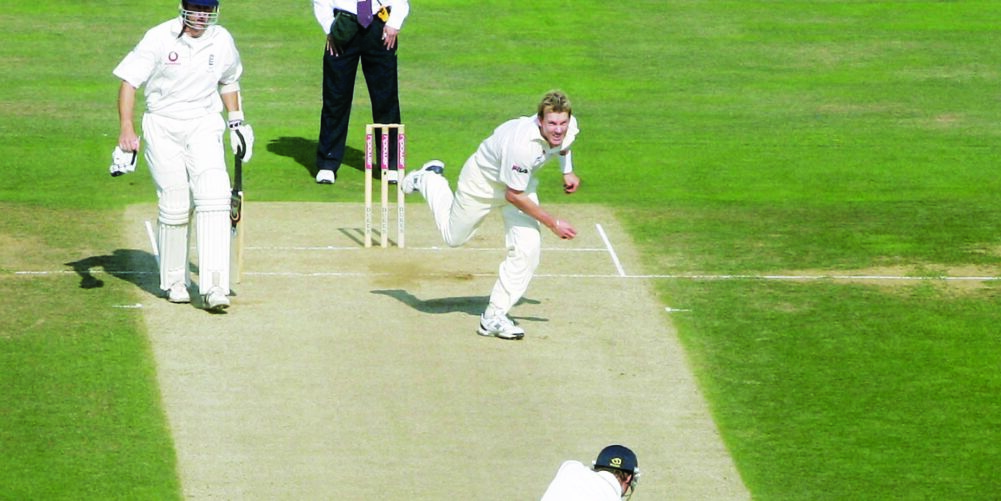Simon Jones can still visualise the situation now. Being stuck at the striker’s end as Brett Lee tore in, peppering him with short balls, many of which were clocked at considerably north of 90mph.
It was the unforgettable summer of 2005 – but this is one moment that England’s Ashes hero from 14 years ago has gladly put to the back of his mind.
“Brett Lee bowled a spell at me when he was 90(mph) plus, the whole time – I think he actually got up to 96 at one point,” says the Welshman.
“Now, that’s not a nice feeling, particularly for me as a late-order batter.
“But I managed to survive and then Kasper (Michael Kasprowicz) came on. Although he was still bowling mid-80s, it felt like nothing.
“That extra seven, eight, nine miles an hour is vast, absolutely vast. There was no comparison between them.
“If you can get up to 93 or 94 miles an hour then you’re making it a completely different game.”
Just ask the West Indies top-order.
In their comfort zone for the majority of the opening two Tests of the series, Mark Wood’s spell at St Lucia on Sunday afternoon deposited them in an alternate place.
Suddenly, the likes of Shimron Hetmyer, who had looked a million dollars in Antigua against Jimmy Anderson and Sam Curran, resembled a cat on a hot tin roof as England’s attacking options were instantly transformed.
It was a similar story in the 2013/14 Ashes, when Mitchell Johnson bowled at the speed of light and England’s fortunes unravelled at a similarly rapid pace.
England have been crying out for a bowler capable of emulating the former Australian left-armer ever since and Wood’s Exocets in St Lucia have provided hope that the Durham man can offer an attacking edge that Joe Root’s side have previously lacked.
Jones, of course, was part of perhaps the quickest attack in England’s Test history. Combined with Steve Harmison and Andrew Flintoff, England had three bowlers capable of stretching the speed gun and hitting 90mph regularly.
Now Wood – who was clocked at 95mph in St Lucia – has set the bar even higher. “No-one is comfortable when the ball is flying around at that sort of pace,
I don’t care who you are,” says Jones.
“He has good skills as well. He bowled a really quality spell and he took those five wickets without bowling that many overs. That’s the impact that pace can have. It scrambles batsmen’s mind,
it makes them uncertain.
“England haven’t had that throughout the series. Jimmy and Stuart Broad’s skills are exceptional but although their pace is good, it’s not express. And bowling that kind of express pace can be the difference between picking up two or three wickets and picking up five, which he obviously did in St Lucia.”
Wood’s first over in the third Test was probably fast enough for the selectors to not so much pencil him in for the Ashes but ensure that his name was at the top of the list in permanent marker.
By the time his spell was finished, Trevor Bayliss and Ed Smith must have been doing metaphorical cartwheels in the realisation that this trip to the Caribbean had finally delivered some hope for the summer, rather than an ever-lengthening list of concerns.
The challenge now is for England to keep him fit, which might be easier said than done for a cricketer who has spent a large proportion of the last two years recovering from injury.
Jones himself was no stranger to the wear and tear that fast bowling can deliver to the body, having had his career decimated by a series of blows that restricted him to just 18 Test matches between 2002 and 2005.
Now heading up his own coaching academy, he admits to seeing something of himself in Wood and also believes that managing the pace ace’s workload in the coming months could have a huge impact on England’s 2019 fortunes.
“I was watching his action and he maybe looks pretty similar,” says Jones. “He looks comfortable with bowling fast and that’s important.
“I had a really long run-up when I first started in 1997 – I think it was something like 26 paces. I was running for miles.
“Then I obviously got that knee injury, but my run-up was never short. It was probably 18 or 19 paces, it wasn’t ridiculous. I think the way I ran in may have made it look shorter than it was.
“It worked for me and it’s clearly working for Mark as well.
“At the end of the day, fast bowlers get injuries because it’s not a natural thing to do and it puts a tremendous strain on your body. He has to play as much as he possibly can. We need him going into that Ashes series as confident as possible and that’s going to be down to the management – that’s what they’re paid the big bucks for, for decisions like this.”
If they get it right, then England may just have found a weapon capable of downing Australia. Get it wrong and it could be a long old summer.
For more information on the Simon Jones Cricket Academy please visit www.simonjonescricket.com
RICHARD EDWARDS | GETTY IMAGES












